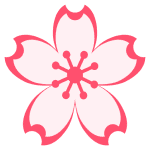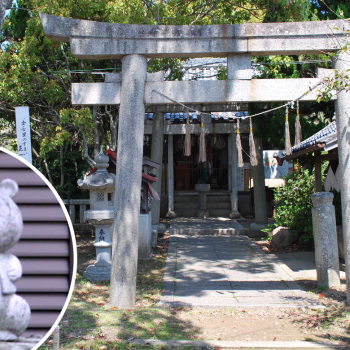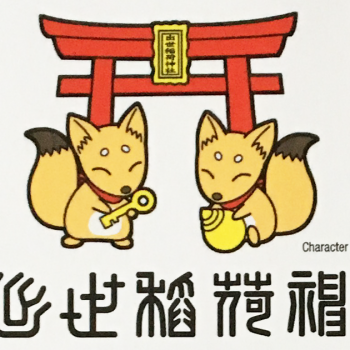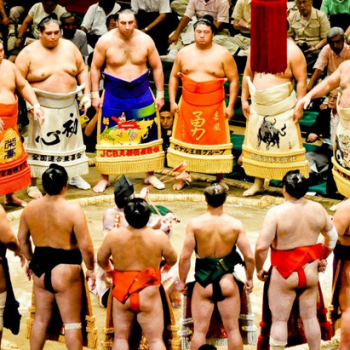Believe it or not, millions of people all over the world are now being exposed to Shinto on a daily basis. How? Through emoji!
The word “emoji” is in fact a Japanese word, literally meaning “picture-word” – contrary to popular belief, the emo part is unrelated to the English word “emotion.” As one might guess, emoji as we know them today were first featured on Japanese mobile phones. Apple and Android got in on the act and decided to incorporate these emoji in their systems, and imported them directly from the Japanese set. As a result, device users from all over the world have access to a huge range of emoji that have specific significance in Japanese culture. Which is fantastic, but some of the symbols can be rather puzzling for those who are not familiar with Japanese culture.
To help raise understanding of the meanings behind these bewildering Japanese emoji, I’ve listed some of them below with explanations. There’s dozens of emoji related to all kinds of Japanese cultural aspects, so I’ve stuck mainly with the ones that have particular links with Shinto.
Cherry blossom, or sakura, are one of the most well-known symbols of Japan. The beautiful pink, five-petalled flowers bloom for only a brief period in spring, prompting thousands of people to participate in the tradition of hanami – flower-viewing parties. Families, friends and co-workers will all gather beneath the cherry trees to eat, drink and enjoy the start of spring and the beauty of the new life around them. Cherry blossoms not only symbolise the new life of spring, but also life’s fleeting nature.
The legendary creature known as ryū in Japan and long in China is often translated as “Chinese dragon” in English. The ryū is large, powerful and reptilian with the ability to fly, but that’s really where the similarity between ryū and the dragons of Western mythology end. While dragons in most Western traditions symbolise fearsome guardians, and in Christianity became associated with the Devil, in Asia the Chinese dragon is usually regarded as a benevolent creature. In Japan, ryū are often associated with kami (deities) of water, and they have connections with Buddhism as well. The Chinese dragon is one of the twelve animals of the Chinese (and Japanese) zodiac, and in fact all the animals of this zodiac are included in the standard emoji sets.
Westerners usually associated joined hands with prayer – and this is the same in Japan! When praying at a Shinto shrine, the Japanese will clap their hands and hold them together to pray, in a similar way to Christians. The Japanese will also gesture with joined hands, usually raised to the level of their heads, to show that they are wishing for something (including making a request to someone), or to make a light apology; they do not, despite common belief, used joined hands as a usual greeting – this is a gesture more likely to be seen in India or Thailand.
 Hina Matsuri dolls
Hina Matsuri dolls
This cute emoji depicts hina-ningyō – dolls representing an Emperor and Empress displayed at Hina Matsuri, Japan’s “Doll Festival,” which falls on March 3rd. You can read more about the Doll Festival here.
 Kadomatsu
Kadomatsu
The kadomatsu is a display of bamboo, pine and sometimes plum branches that is placed outside homes around Shōgatsu – Japanese New Year, on January 1st. Shōgatsu is perhaps Japan’s most important festival, analogous to Christmas in the West. The kadomatsu functions as a temporary shintai – a dwelling place for kami during the New Year period. Each of the plants in the kadomatsu has a particular meaning: The bamboo represents prosperity, the pine longevity, and the plum perseverance.
 Koi nobori
Koi nobori
Koi nobori, or carp streamers, are decorations displayed around Kodomo no Hi (translated as “Children’s Day” or “Boy’s Day”) on May 5th. They traditionally represent the father and sons of the household, and are hung in order to pray for the healthy growth of children. You can read more about koi nobori and Kodomo no Hi here.
 Lantern
Lantern
This emoji is often called the “izakaya lantern,” as it depicts the chōchin, or red paper lantern, often displayed outside izakaya – traditional Japanese eateries sometimes compared to pubs in the UK. But chōchin are not limited to izakaya; you’ll also see them at Japanese festivals and illuminating Shinto shrines.
 Mount Fuji
Mount Fuji
Mount Fuji is often paired with the cherry blossom as a symbol of Japan, and with good reason – it is one of Japan’s most sacred places. An active volcano, Mount Fuji (known as Fujisan in Japan) is Japan’s highest mountain and can be seen from Japan’s capital, Tokyo. It is important in both Shinto and Buddhism and is one of Japan’s most popular places of pilgrimage – traditionally, one climbs Mount Fuji at night in order to witness the sunrise when reaching the top.
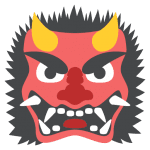 Oni
Oni
Often translated as “ogre” or “demon” in English, the oni is a mythical creature with red or blue skin, horns, and sharp teeth. They are common in Japanese folktales, particularly the tale of Momotarō in which a boy hero born from a peach goes to fight oni who have been terrorising his village. Some consider oni to be a kind of kami, and indeed they are an important symbol of the festival of Setsubun on February 3rd, representing negativity that is banished by throwing beans. You can read more about Setsubun here.
 Tanabata
Tanabata
Tanabata is a festival held on July 7th. It celebrates two star deities who are considered lovers, Orihime (Vega) and Hikoboshi (Altair), who are separated by the Milky Way and can only meet once a year on the night of Tanabata. It is believed that at this time, wishes will be granted. People write their wishes on strips of coloured paper and hang them on bamboo, which is what is depicted in this emoji.
 Tengu
Tengu
Like the oni, the tengu is another Japanese mythical creature. Tengu are usually depicted as half-human, half-bird creatures with wings, a red face and either a long nose or beak. They have a rather ambiguous character, as they are depicted both as fearsome, warlike demons, and helpful teachers that guard mountains and forests. In Shinto they are connected with Sarutahiko Ōkami, leader of all Earthly Kami, and Amanozako, offspring of the storm kami Susanō. Tengu are also associated with yamabushi, the mountain warrior-ascetics who practise the esoteric tradition of Shugendō.


 Three Wise Monkeys
Three Wise Monkeys
These three different emoji represent the san-zaru – the “Three Wise Monkeys” who represent the Japanese proverb “mizaru, kikazaru, iwazaru,” often translated as “see no evil, hear no evil, speak no evil.” You can read more about what this proverb means, and why monkeys are used to represent it, here.
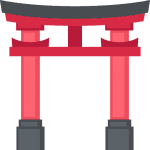 Torii
Torii
The torii is probably the most frequently-used symbol of Shinto. Torii are archways found at the entrance to Shinto shrines and other sites of Shinto significance, and represent the barrier between the mundane world and world of kami. Torii vary greatly in size, shape and composition, but they are often made of wood and painted vermilion red.
 Tsukimi
Tsukimi
Neopagans aren’t the only ones who hold rituals at the full moon – Shintoists do too! In Japan, there is a special festival held at the full moon in September (and sometimes October), called Tsukimi – the Moon Viewing festival. At Tsukimi, people traditionally make an offering of tsukimi-dango, “moon viewing dumplings,” and pampass grass to the moon. Seasonal foods, such as chestnuts and sweet potatoes (which have also been made into emoji), may also be offered to the moon. This emoji depicts three of the symbols of Tsukimi – pampass grass, a tray of tsukimi-dango, and of course the full moon itself.
 Person bowing deeply
Person bowing deeply
Bowing is extremely important in Japan. It’s used as a greeting, an expression of gratitude, a way of apologising, and of course a gesture of respect towards the kami. The deep bow in this emoji would be used to express profound gratitude or perhaps an apology.
 Prayer beads
Prayer beads
In Japan, prayer beads (or juzu) are really associated with Buddhism rather than Shinto. Like Christian rosaries, juzu are used while chanting prayers, where they are rubbed together in order to purify the practitioner.
 Rice plant
Rice plant
By far Japan’s most important plant in terms of its role in Japanese history. Shinto is deeply connected with rice cultivation, with many rituals intended to promote the fertility of rice. Perhaps Japan’s most important rice deity is Inari Ōkami.
 Sake
Sake
Brewed from rice, sake rice-wine holds a similar status of importance in Shinto as the rice itself. It is commonly offered to the kami, as well as drunk at Shinto festivals. This emoji depicts a tokkuri (flask) with a choko (cup) containing the sake.
 Wind chime
Wind chime
Wind chimes, or fūrin, are a common sight in Japan in the summer time, as the sound is said to be soothing and cooling in the humid heat. What’s more, the chimes are thought to ward off evil spirits; particularly important in the summer, which is the season most commonly associated with ghosts and demons in Japan.
Now you know what these emoji mean, please have fun using them in your own messages and impress your friends with your knowledge of Japanese culture!
All emoji images from EmojiOne.


